Numerical Simulation Based Targeting of the Magushan Skarn Cu–Mo Deposit, Middle-Lower Yangtze Metallogenic Belt, China
Abstract
:1. Introduction
2. Regional and Deposit Geology
2.1. Regional Geology
2.2. Orefield Geology
2.3. Deposit Geology
3. Modeling of the Magushan Skarn Deposit
3.1. Conceptual Model and Conditions
3.2. Simulation Modeling
3.3. Mathematical Modeling
3.3.1. Heat Transfer and the Body Force
3.3.2. Fluid-Flow Driven by Pressure Differentiation
3.3.3. Chemical Reactions and Coupling Equations with Heat Transfer
3.3.4. Transport of Dilute Minerals in Porous Rocks
4. Results
4.1. Simulated Ore-Forming Processes
4.2. Sensitivity Testing
5. Discussion
6. Conclusions
Supplementary Materials
Author Contributions
Funding
Acknowledgments
Conflicts of Interest
References
- Mudd, G.M.; Weng, Z.; Jowitt, S.M. A detailed assessment of global Cu resource trends and endowments. Econ. Geol. 2013, 108, 1163–1183. [Google Scholar] [CrossRef]
- Mudd, G.M.; Jowitt, S.M. Growing global copper resources, reserves and production: Discovery is not the only control on supply. Econ. Geol. 2018, 113, 1235–1267. [Google Scholar] [CrossRef]
- Mudd, G.M.; Jowitt, S.M.; Werner, T.T. The world’s lead-zinc mineral resources: scarcity, data, issues and opportunities. Ore Geol. Rev. 2017, 80, 1160–1190. [Google Scholar] [CrossRef]
- Meinert, L.D.; Dipple, G.M.; Nicolescu, S. World skarn deposits. In Econ. Geol. 100th Aniv. Vol., 1st ed.; Hedenquist, J.M., Thompson, J.F.H., Goldfarb, R.J., Richards, J.P., Eds.; Society of Econmic Geologists: Littleton, CO, USA, 2005; Volume 11, pp. 299–336. [Google Scholar]
- Chang, Y.F.; Liu, X.P.; Wu, Y.C. The Copper-Iron Belt of the Lower and Middle reaches of the Changjiang River, 1st ed.; Geological Publishing House: Beijing, China, 1991; pp. 1–379. [Google Scholar]
- Pirajno, F.; Zhou, T.F. Intracontinental porphyry and porphyry skarn mineral systems in eastern China: Scrutiny of a special case “made-in-China”. Econ. Geol. 2015, 110, 603–629. [Google Scholar] [CrossRef]
- Zhou, T.F.; Wang, S.W.; Fan, Y.; Yuan, F.; Zhang, D.Y.; White, N.C. A review of the intracontinental porphyry deposits in the Middle-Lower Yangtze River Valley metallogenic belt, Eastern China. Ore Geol. Rev. 2015, 65, 433–456. [Google Scholar] [CrossRef]
- Xiao, Q.L.; Zhou, T.F.; Wang, S.W.; Yuan, F.; White, N.C.; Wang, F.Y.; Xie, Z.J.; Liu, J. Genesis of Chating Cu-Au deposit in the Middle-Lower Yangtze River Metallogenic Belt, Eastern China: Implications from magnetite and biotite geochemistry. Ore Geol. Rev. 2019, 106, 113–133. [Google Scholar] [CrossRef]
- Xu, X.C.; Ji, K.; Bai, R.Y.; Qian, S.L.; Yang, Q.G.; Xie, Z.J. Modes of Occurrence of Gold and Genetic Connection between Gold and Copper in the Ores from the Chating Porphyry Copper-Gold deposit, Xuancheng City, Anhui Province. Acta Petro. Mineral. 2018, 37, 575–589. [Google Scholar]
- Jiang, F.; Xu, X.C.; Qian, S.L.; Wang, M.; Yang, Q.G.; Li, K. Zircon U-Pb Age and Genesis of the Ore-bearing Quartz-diorite Porphyries in the Chating Cu-Au Ore Deposit, Xuancheng City, Anhui Province. Geol. J. China Univ. 2017, 23, 591–605. [Google Scholar]
- Zhou, T.F.; Fan, Y.; Wang, S.W.; White, N.C. Metallogenic regularity and Metallogenic model of the Middle-Lower Yangtze River Valley Metallogenic Belt. Acta Petrol. Sin. 2017, 33, 3353–3372. [Google Scholar]
- Porwal, A.; Gonzalez-Alvarez, I.; Markwitz, V.; McCuaig, T.; Mamuse, A. Weights of-evidence and logistic regression modeling of magmatic nickel sulfide prospectivity in the Yilgarn Craton, Western Australia. Ore Geol. Rev. 2010, 38, 184–196. [Google Scholar] [CrossRef]
- Porwal, A.; Carranza, E.J.M. Introduction to the Special Issue: GIS-based mineral potential modelling and geological data analyses for mineral exploration. Ore Geol. Rev. 2015, 71, 477–483. [Google Scholar] [CrossRef]
- Mao, X.C.; Jia, R.; Liu, Z.K.; Chen, J.; Tang, L.; Deng, H.; Bayless, R.C.; Yang, B.; Wang, M.J.; Liu, C.M. Three-dimensional prospectivity modeling of the Jiaojia-type gold deposit, Jiaodong Peninsula, Eastern China: A case study of the Dayingezhuang deposit. J. Geochem. Explor. 2019, 203, 27–44. [Google Scholar] [CrossRef]
- Li, X.H.; Yuan, F.; Zhang, M.M.; Jia, C.; Jowitt, S.M.; Ord, A.; Zheng, T.K.; Hu, X.Y.; Li, Y. Three-dimensional mineral prospectivity modeling for targeting of concealed mineralization within the Zhonggu iron orefield, Ningwu Basin, China. Ore Geol. Rev. 2015, 71, 633–654. [Google Scholar] [CrossRef]
- Hu, X.Y.; Yuan, F.; Li, X.H.; Jowitt, S.M.; Jia, C.; Zhang, M.M.; Zhou, T.F. 3D characteristic analysis-based targeting of concealed Kiruna-type Fe oxide-apatite mineralization within the Yangzhuang deposit of the Zhonggu orefield, southern Ningwu volcanic basin, middle-lower Yangtze River metallogenic Belt, China. Ore Geol. Rev. 2018, 92, 240–256. [Google Scholar] [CrossRef]
- Hobbs, B.; Regenauer-Lieb, K.; Ord, A. Thermodynamics of folding in the middle to lower crust. Geology 2007, 35, 175–178. [Google Scholar] [CrossRef]
- Oliver, N.H.; McLellan, J.G.; Hobbs, B.E.; Cleverley, J.S.; Ord, A.; Feltrin, L. Numerical models of extensional deformation, heat transfer, and fluid flows across basement-cover interfaces during basin-related mineralization. Econ. Geol. 2006, 101, 1–31. [Google Scholar] [CrossRef]
- Ord, A.; Hobbs, B.E.; Lester, D.R. The mechanics of hydrothermal systems: I. Ore systems as chemical reactors. Ore Geol. Rev. 2012, 49, 1–44. [Google Scholar] [CrossRef]
- Cooke, D.R.; McPhail, D.C. Epithermal Au–Ag–Te mineralization, Acupan, Baguio district, Philippines: Numerical simulations of mineral deposition. Econ. Geol. 2001, 96, 109–131. [Google Scholar]
- Li, X.H.; Yuan, F.; Zhang, M.M.; Jowitt, S.M.; Ord, A.; Zhou, T.F.; Dai, W.Q. 3D computational simulation-based mineral prospectivity modeling for exploration for concealed Fe–Cu skarn-type mineralization within the Yueshan orefield, Anqing district, Anhui Province, China. Ore Geol. Rev. 2019, 105, 1–17. [Google Scholar] [CrossRef]
- 812 Geological Team of Eastern China Bureau of Geological Exploration & Metallurgy. Report of Resources and Reserves of Magushan Cu–Mo Deposit; 812 Geological Team of Eastern China Bureau of Geological Exploration & Metallurgy: Xuancheng, China, 2010. [Google Scholar]
- Geological Exploration Technology Institute of Anhui Province. Geophysical Test Report of Nanling–Xuancheng Aera; Geological Exploration Technology Institute of Anhui Province: Hefei, China, 2016. [Google Scholar]
- Tang, Y. Geology of Copper-Gold Polymetallic Deposits in the Along-Changjiang Area of Anhui Province, 1st ed.; Geological Publishing House: Beijing, China, 1998; pp. 1–351. [Google Scholar]
- Zhai, Y. Metallogenic Regularity of Iron and Copper (Gold) Deposits in the Middle and Lower Valley of the Yangtze River, 1st ed.; Geological Publishing House: Beijing, China, 1992; pp. 1–235. [Google Scholar]
- Pan, Y.; Dong, P. The Lower Changjiang (Yangzi/Yangtze River) metallogenic belt, east central China: Intrusion-and wall rock-hosted Cu–Fe–Au, Mo, Zn, Pb, Ag deposits. Ore Geol. Rev. 1999, 15, 177–242. [Google Scholar] [CrossRef]
- Yuan, F.; Zhou, T.F.; Liu, J.; Fan, Y.; Cooke, D.R.; Jowitt, S.M. Petrogenesis of volcanic and intrusive rocks of the Zhuanqiao stage, Luzong Basin, Yangtze metallogenic belt, east China: Implications for ore deposition. Int. Geol. Rev. 2011, 53, 526–541. [Google Scholar] [CrossRef]
- Zhao, Z.; Tu, G. Super-Large Ore Deposits in China (II), 1st ed.; Science Press: Beijing, China, 2003; pp. 1–631. [Google Scholar]
- Zhou, T.F.; Fan, Y.; Yuan, F.; Zhang, L.; Ma, L.; Qian, B.; Xie, J. Petrogensis and metallogeny study of the volcanic basin in the Middle and Lower Yangtze Metallogenic Belt. Acta Geol. Sin. 2011, 85, 712–730. [Google Scholar]
- Ningwu Research Group. Ningwu Porphyry Iron Ores, 1st ed.; Geological Publishing House: Beijing, China, 1978; pp. 1–196. [Google Scholar]
- Anhui 322 Geological Team. Geological Report of Chating Cu Polymetallic Deposit; Anhui 322 Geological Team: Xuanzhou, China, 2016. [Google Scholar]
- Zhao, C.B.; Hobbs, B.E.; Ord, A. Investigating dynamic mechanisms of geological phenomena using methodology of computational geosciences: An example of equaldistant mineralization in a fault. Sci. China Ser. D 2008, 51, 947–954. [Google Scholar] [CrossRef]
- Zhao, C.B.; Hobbs, B.E.; Ord, A. Fundamentals of Computational Geoscience: Numerical Methods and Algorithms, 1st ed.; Springer: Berlin, Germany, 2009; pp. 1–241. [Google Scholar]
- Zou, Y.H.; Liu, Y.; Dai, T.G.; Mao, X.C.; Lei, Y.B.; Lai, J.Q.; Tian, H.L. Finite difference modeling of metallogenic processes in the Hutouya Pb-Zn deposit, Qinghai, China: Implications for hydrothermal mineralization. Ore Geol. Rev. 2017, 91, 463–476. [Google Scholar] [CrossRef]
- Burnham, C.W. Energy release in subvolcanic environments; implications for breccia formation. Econ. Geol. 1985, 80, 1515–1522. [Google Scholar] [CrossRef]
- Ji, K. Mineralogy and Fluid Inclusion Geochemistry of the Chating Cu-Au Deposit, Xuancheng City. Master’s Thesis, Hefei University of Technology, Hefei, China, 2018. [Google Scholar]
- Meinert, L.D. Skarns and skarn deposits. Geosci. Can. 1992, 19, 145–162. [Google Scholar]
- Bickle, M.J. Heat loss from the Earth: A constraint on Archaean tectonics from the relation between geothermal gradients and the rate of plate production. Earth Planet. Sci. Lett. 1978, 40, 301–315. [Google Scholar] [CrossRef]
- Lister, C.R.B. Geothermal gradient measurement using a deep sea corer. Geophys. J. Int. 1963, 7, 571–583. [Google Scholar] [CrossRef]
- Anderson, D.L. Theory of the Earth, 1st ed.; Blackwell Scientific Publications: Hoboken, NJ, USA, 1989; pp. 1–379. [Google Scholar]
- Hart, B.S.; Flemings, P.B.; Deshpande, A. Porosity and pressure: Role of compaction disequilibrium in the development of geopressures in a Gulf Coast Pleistocene basin. Geology 1995, 23, 45–48. [Google Scholar] [CrossRef]
- Hu, B.Q.; Wang, F.Z.; Sun, Z.X.; Liu, C.D.; Bai, L.H. The Pressure Gradient in the Lithosphere. Earth Sci. Front. 2003, 10, 129–133. [Google Scholar]
- Mandl, G. Mechanics of Tectonic Faulting, 1st ed.; Elsevier: Amsterdam, The Netherlands, 1988; pp. 1–407. [Google Scholar]
- Kumar, A.; Pramanik, S.; Mishra, M. COMSOL Multiphysics® Modeling in Darcian and Non-Darcian Porous Media. In Proceedings of the 2016 COMSOL Conference, Bangalore, India, 20–21 October 2016. [Google Scholar]
- Zhang, Z.; Li, J.; Zhou, J. Microscopic roles of “viscoelasticity” in HPMA polymer flooding for EOR. Trans. Porous Media 2011, 86, 199–214. [Google Scholar] [CrossRef]
- Emmermann, R.; Lauterjung, J. The German continental deep drilling program KTB: Overview and major results. J. Geophys. Res. 1997, 102, 18179–18201. [Google Scholar] [CrossRef]
- Huerta, A.D.; Nyblade, A.A.; Reusch, A.M. Mantle transition zone structure beneath Kenya and Tanzania: More evidence for a deep-seated thermal upwelling in the mantle. Geophys. J. Int. 2009, 177, 1249–1255. [Google Scholar] [CrossRef]
- Liu, J.X.; Hu, H.J.; Liu, C.M.; Han, S.L.; Xie, W. Application of Synthetical Geophysical Method on Exploration of Deep-seated Resources. Geol. Prospect. 2006, 4, 71–74. [Google Scholar]
- Nykänen, V.; Salmirinne, H. Prospectivity analysis of gold using regional geophysical and geochemical data from the Central Lapland Greenstone Belt, Finland. Geol. Surv. Finl. 2007, 44, 251–269. [Google Scholar]
- Yang, H.; Zhang, Y.; Zou, C.N.; Wen, B.H.; Li, J.Z.; Li, M. Exploration scheme of gas in deep-seated volcanic rocks in Songliao Basin. Petro. Explor. Dev. 2006, 33, 274–281. [Google Scholar]
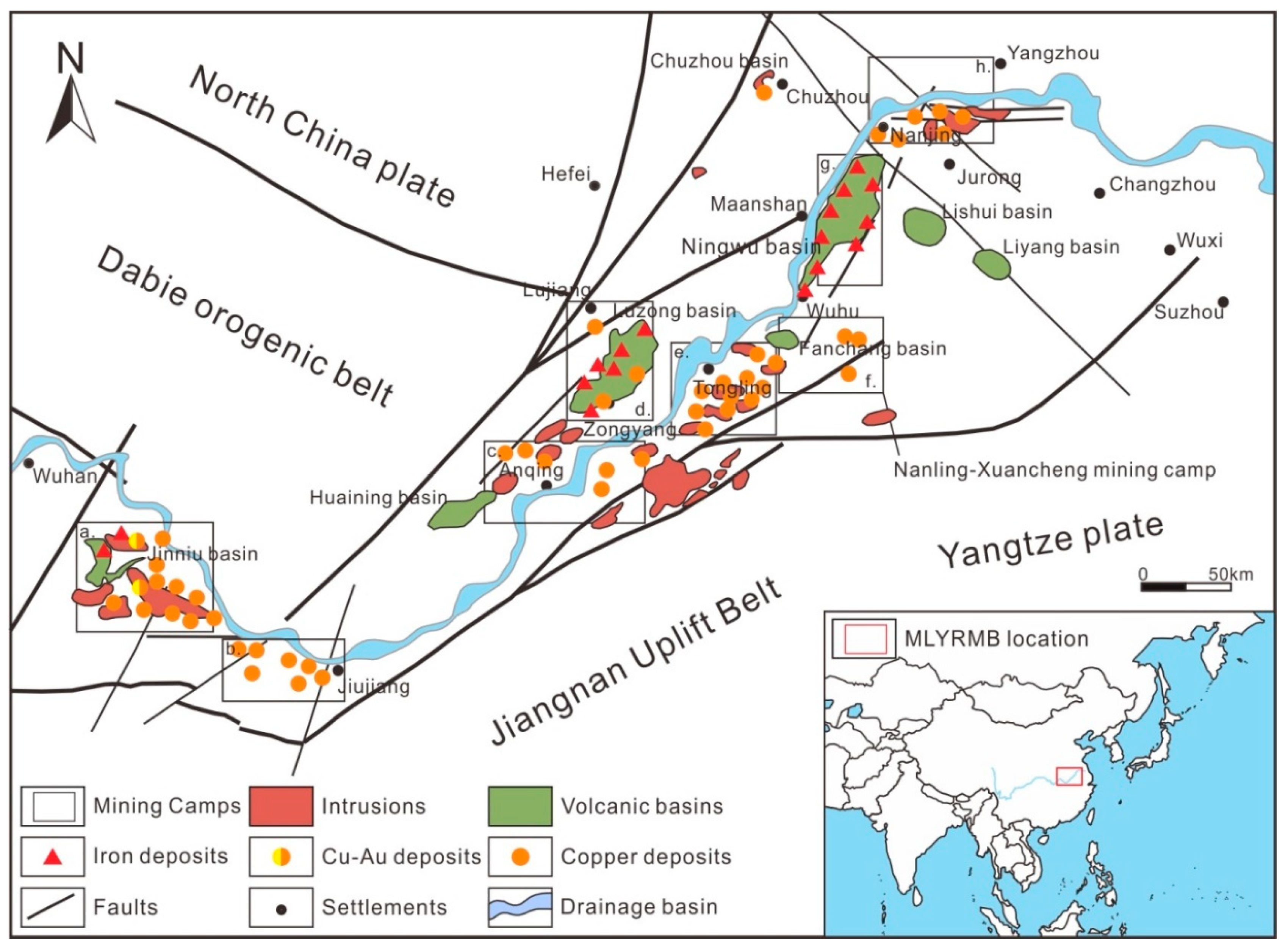

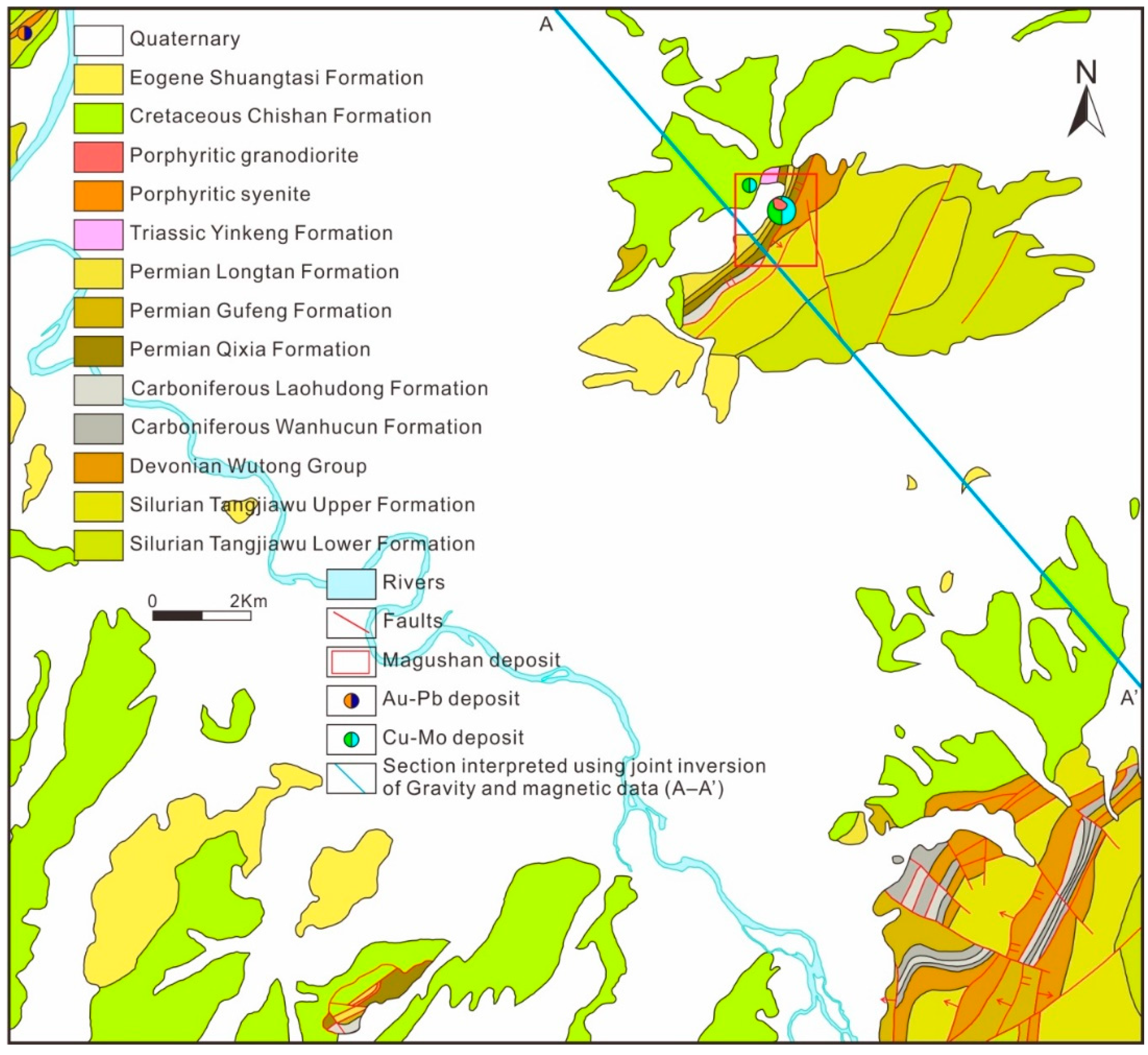
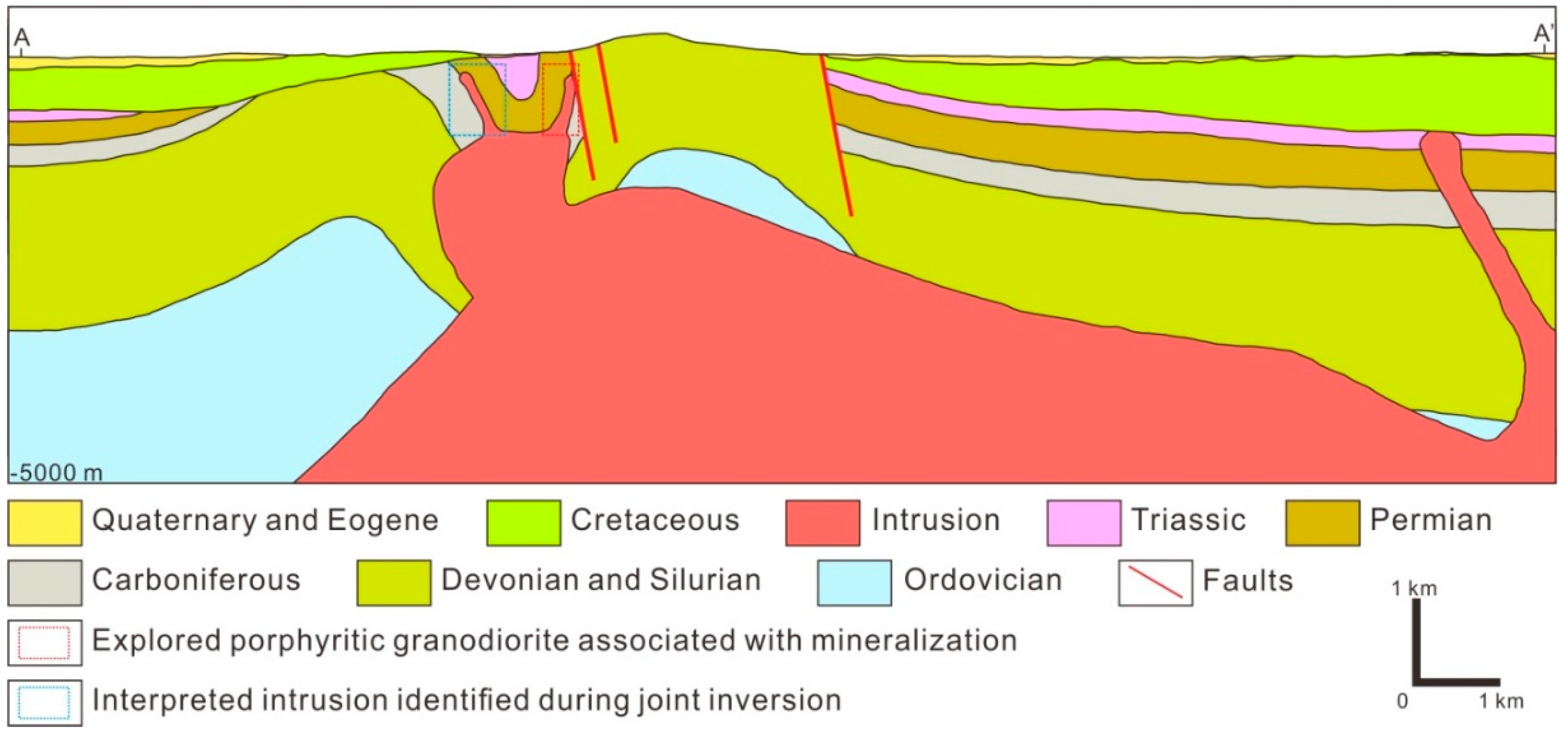
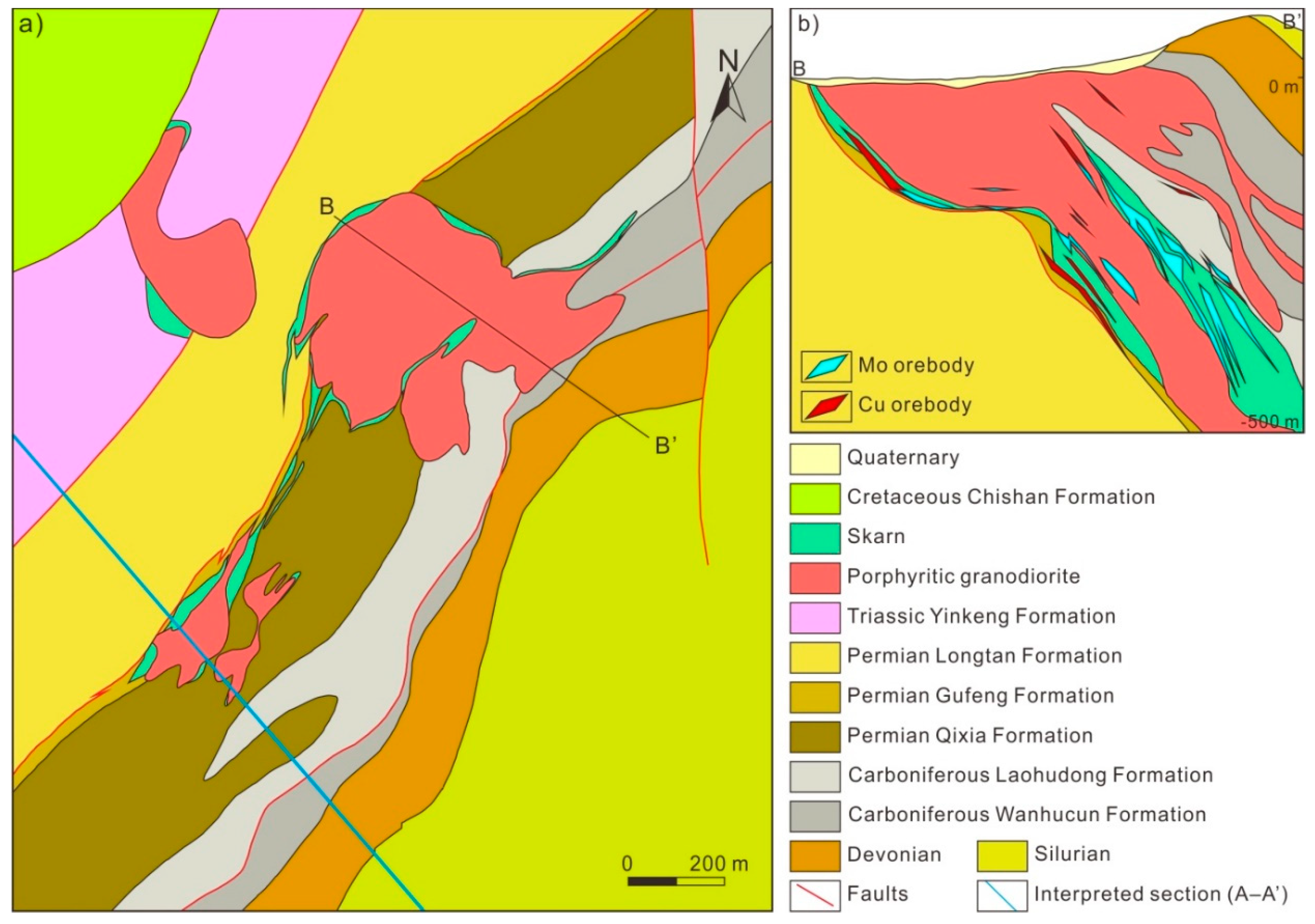
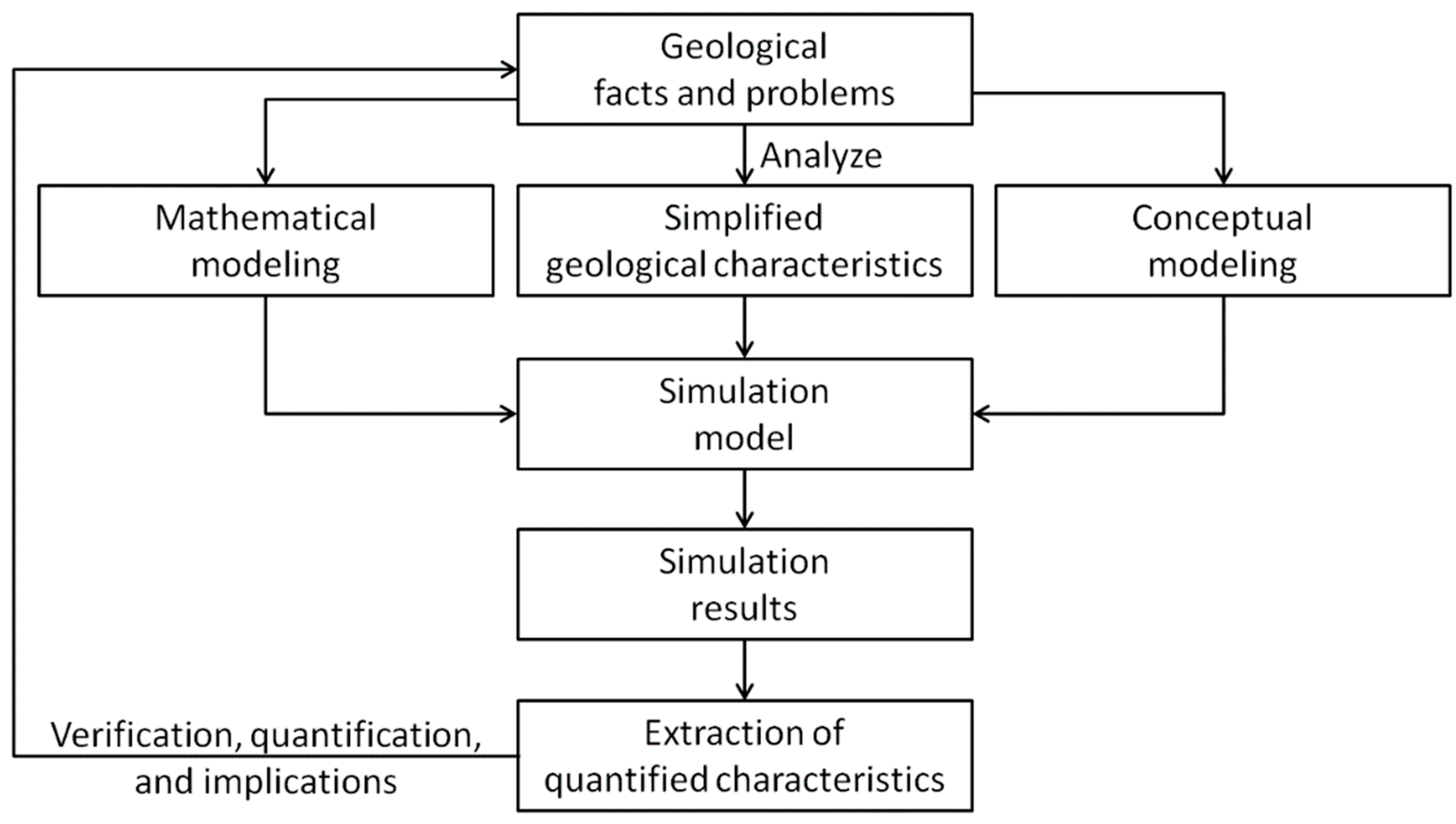
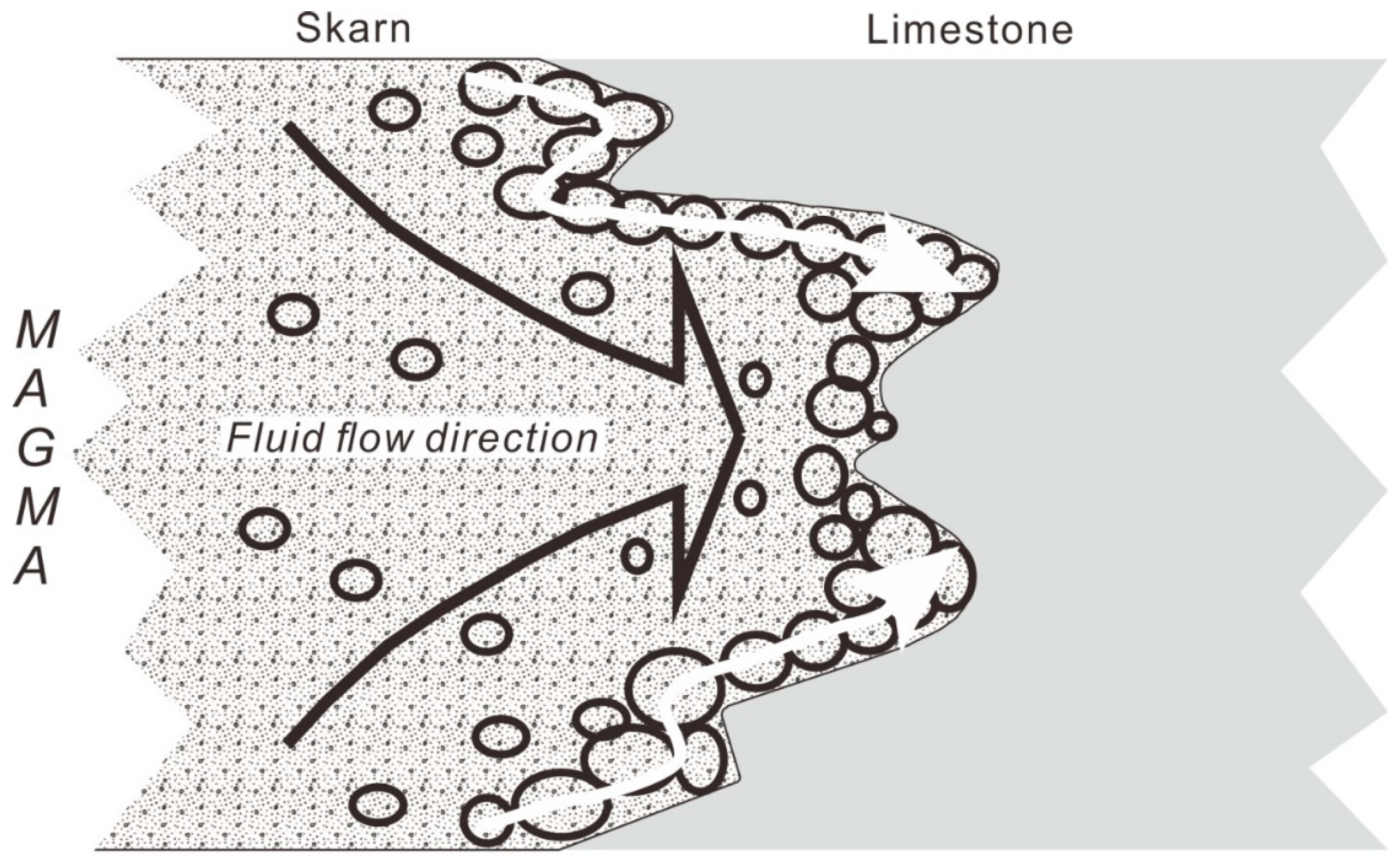

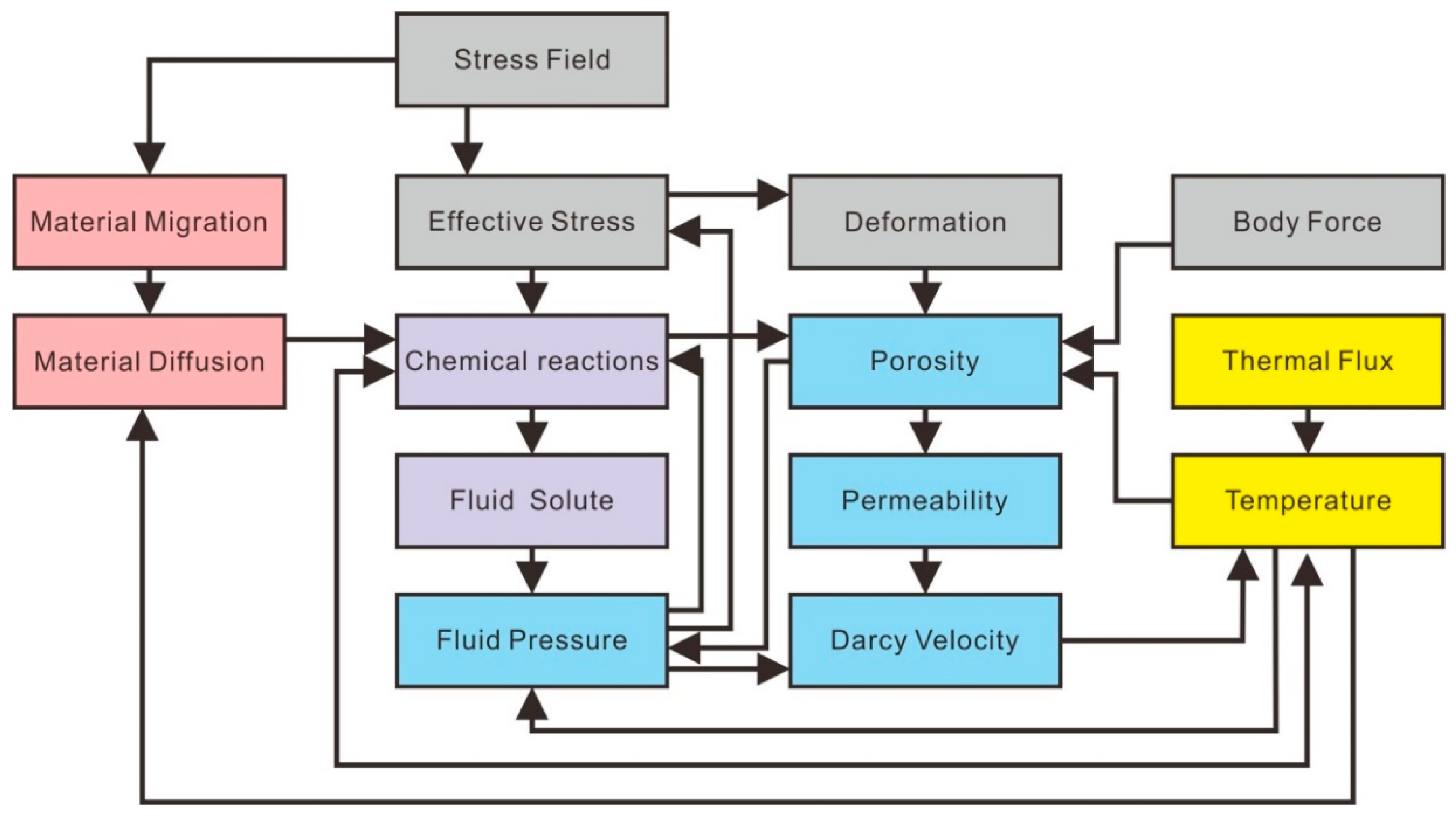
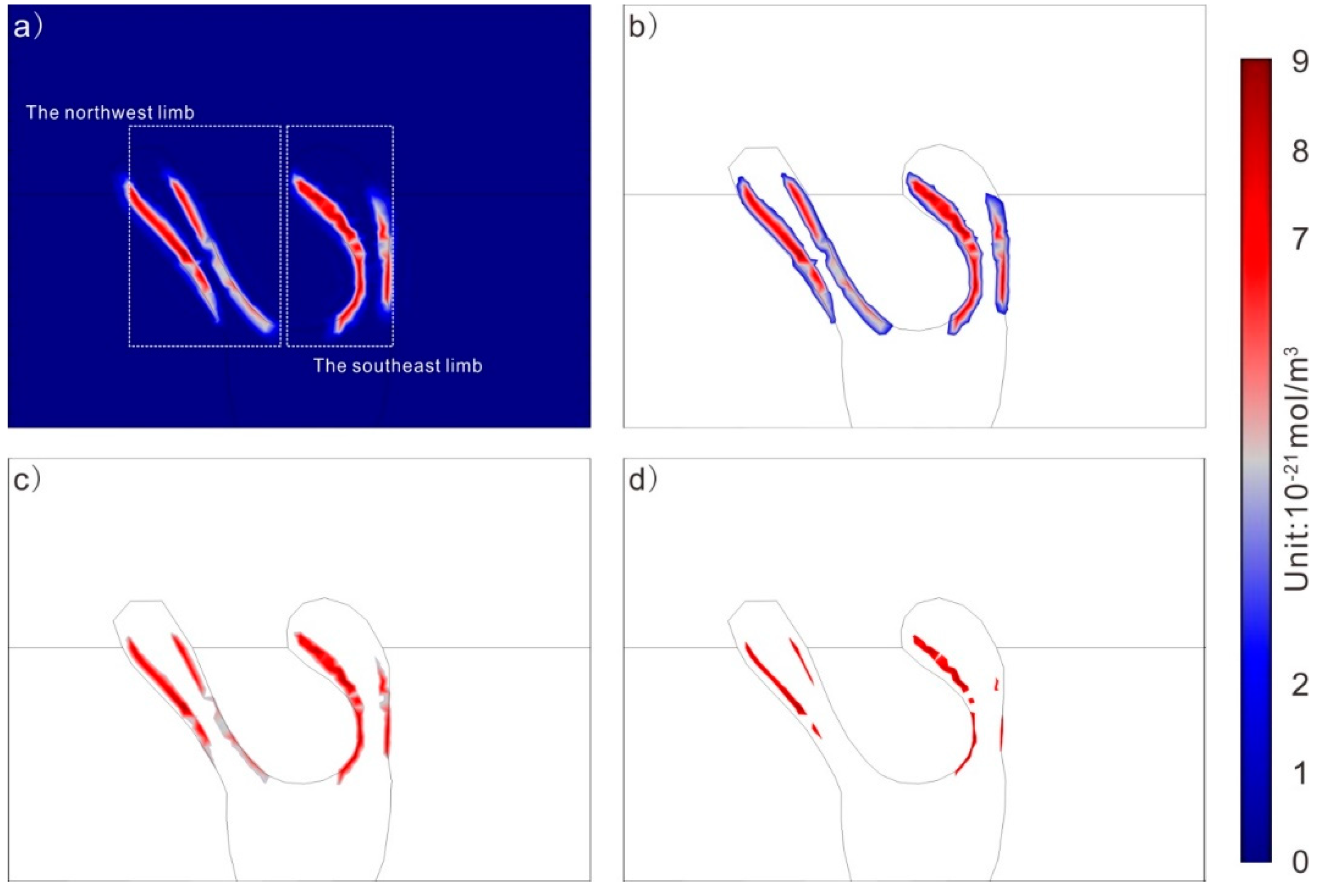

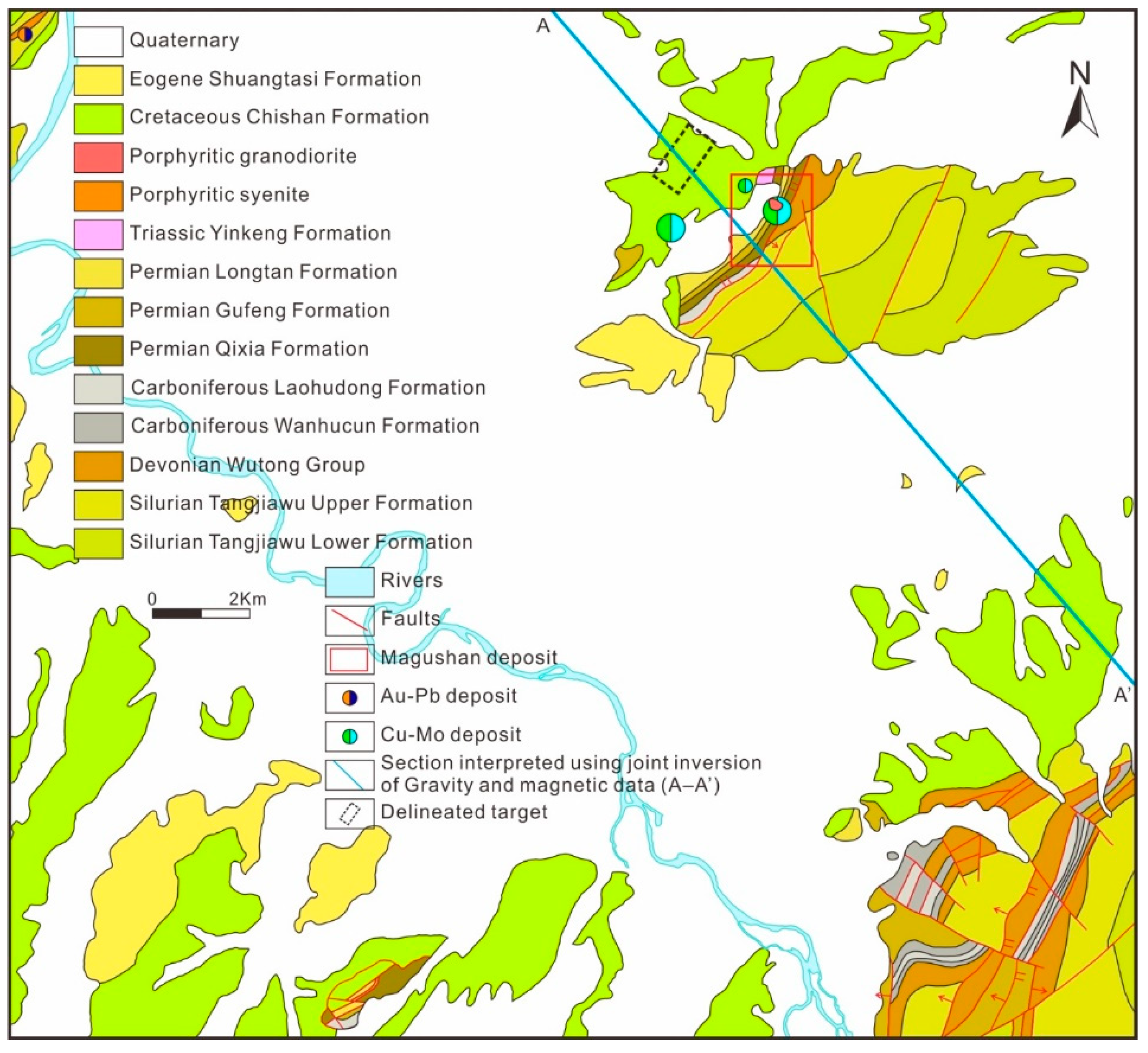

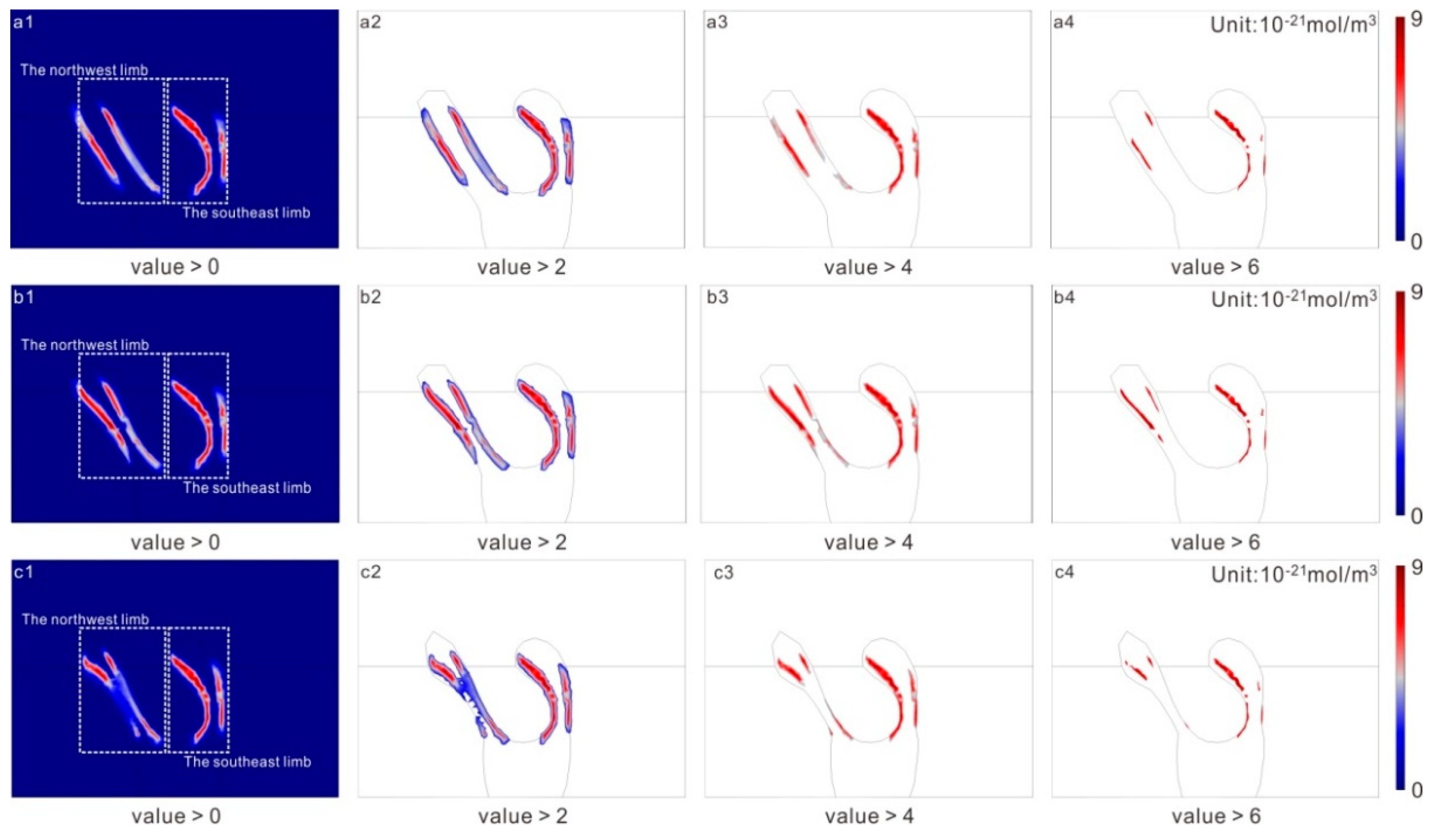

| Age | Lithostratigraphic Unit | Unit Code | Lithological Description | Unit Thickness (m) |
|---|---|---|---|---|
| Quaternary | Q | Clay | 1–30 | |
| Neogene | N | Breccia, mudstone | 0–25 | |
| Paleogene | E | Breccia, mudstone | 0–20 | |
| Cretaceous | Chishan Formation | K2c | Sandstone | 1055–7605 |
| Xuannan Formation | K2x | Quartz sandstone | 50–700 | |
| Pukou Formation | K1p | Sandstone, breccia | 379 | |
| Gecun Formation | K1g | Mudstone, sandstone | >1000 | |
| Zhongfencun Formation | K1z | Limestone, sandstone, andesite | 20–300 | |
| Jurassic | Zhongfencun Formation | J3z | Limestone, sandstone, andesite | 20–300 |
| Triassic | Nanlinghu Formation | T1n | Limestone | 160–645 |
| Helongshan Formation | T1h | Limestone | 130–220 | |
| Yinkeng Formation | T1y | Limestone | 200–300 | |
| Permian | Dalong Formation | P3d | Quartz sandstone | 10–50 |
| Longtan Formation | P2–3l | Quartz sandstone | 100–300 | |
| Gufeng Formation | P2g | Shale | 200–300 | |
| Qixia Formation | P1q | Limestone | 160–300 | |
| Chuanshan Formation | P1c | Limestone | 30–50 | |
| Carboniferous | Huanglong Formation | C2h | Limestone | 30–50 |
| Gaolishan Formation | C1g | Siltstone | 60–90 | |
| Devonian | Wutong Formation | D3w | Quartz sandstone | 85–176 |
| Silurian | Maoshan Formation | S1–2m | Quartz sandstone | 600–900 |
| Fentou Formation | S1f | Lithic sandstone | 800–1500 | |
| Gaojiabian Formation | S1g | Fine-grained sandstone, mudstone, shale | 700–1300 |
| Rock Type | Density (Kg/m3) | Specific Heat Capacity (J/Kg K) | Porosity (/1) | Permeability (m2) | Thermal Expansion Coefficient (10−6/K) | Heat Conductivity (W/m K) |
|---|---|---|---|---|---|---|
| Wall rock | 2650 | 820 | 0.23 | 8.0 × 10−14 | 7 | 2.9 |
| Intrusion | 2650 | 870 | 0.22 | 6.0 × 10−14 | 8 | 2.8 |
| Denuded Cretaceous | 2580 | 780 | 0.26 | 8.6 × 10−14 | 7 | 3.1 |
| Core of the syncline | 2650 | 820 | 0.24 | 8.8 × 10−14 | 8 | 2.9 |
| Formula | Layer Classification | Pressure Gradient (MPa/km) | Calculated Depth (km) |
|---|---|---|---|
| Lithostatic gradient: | Upper crust | 26.5 | 0–15 |
| Middle crust | 29 | 15–24.4 | |
| Lower crust | 33.75 | 24.4–115 | |
| Crust (average) | 30 | Whole crust | |
| Lithosphere (average) | 33 | Whole lithosphere |
| Concentration of Garnet (×10−21 mol/m3) | Area Ratio of Northwest Limb | Area Ration of Southeast Limb |
|---|---|---|
| >2 | 0.022064 | 0.019843 |
| >4 | 0.009651 | 0.006918 |
| >6 | 0.002448 | 0.003103 |
| Model Shape | Concentration of Garnet (×10−21 mol/m3) | Area Ratio of Northwest Limb | Area Ratio of Southeast Limb |
|---|---|---|---|
| Wider northwestern apophysis | >2 | 0.021580 | 0.019387 |
| >4 | 0.008854 | 0.010704 | |
| >6 | 0.001338 | 0.003672 | |
| Original model | >2 | 0.022064 | 0.019843 |
| >4 | 0.009651 | 0.006918 | |
| >6 | 0.002448 | 0.003103 | |
| Thinner northwestern apophysis | >2 | 0.021414 | 0.019098 |
| >4 | 0.006454 | 0.011078 | |
| >6 | 0.001286 | 0.003767 |
© 2019 by the authors. Licensee MDPI, Basel, Switzerland. This article is an open access article distributed under the terms and conditions of the Creative Commons Attribution (CC BY) license (http://creativecommons.org/licenses/by/4.0/).
Share and Cite
Hu, X.; Li, X.; Yuan, F.; Ord, A.; Jowitt, S.M.; Li, Y.; Dai, W.; Ye, R.; Zhou, T. Numerical Simulation Based Targeting of the Magushan Skarn Cu–Mo Deposit, Middle-Lower Yangtze Metallogenic Belt, China. Minerals 2019, 9, 588. https://doi.org/10.3390/min9100588
Hu X, Li X, Yuan F, Ord A, Jowitt SM, Li Y, Dai W, Ye R, Zhou T. Numerical Simulation Based Targeting of the Magushan Skarn Cu–Mo Deposit, Middle-Lower Yangtze Metallogenic Belt, China. Minerals. 2019; 9(10):588. https://doi.org/10.3390/min9100588
Chicago/Turabian StyleHu, Xunyu, Xiaohui Li, Feng Yuan, Alison Ord, Simon M. Jowitt, Yue Li, Wenqiang Dai, Rui Ye, and Taofa Zhou. 2019. "Numerical Simulation Based Targeting of the Magushan Skarn Cu–Mo Deposit, Middle-Lower Yangtze Metallogenic Belt, China" Minerals 9, no. 10: 588. https://doi.org/10.3390/min9100588
APA StyleHu, X., Li, X., Yuan, F., Ord, A., Jowitt, S. M., Li, Y., Dai, W., Ye, R., & Zhou, T. (2019). Numerical Simulation Based Targeting of the Magushan Skarn Cu–Mo Deposit, Middle-Lower Yangtze Metallogenic Belt, China. Minerals, 9(10), 588. https://doi.org/10.3390/min9100588







